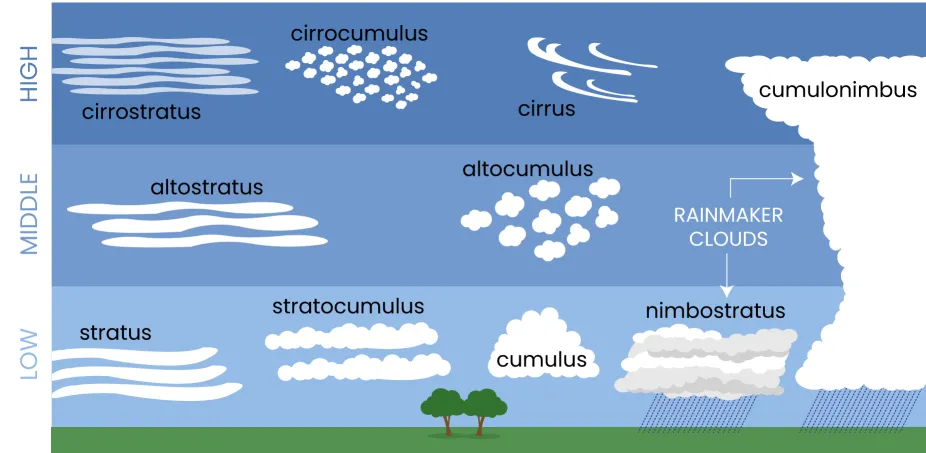If you’re traveling over a thousand miles to put yourself in the path of the total eclipse of the sun, don’t let a few clouds ruin your experience. Sometimes you don’t have to move very far too save your shot.
This idea came from our experience with a lunar eclipse. One night a couple years ago while we were in a campground in Melbourne, Florida. As the appointed time (around 2 am) approached, the clouds started to fill in. By the time I got the idea of jumping in the van, we were looking for holes in the clouds, not evading individual clouds. We wound up moving a few times that night to find better holes in the clouds, and managed to get some clear shots. Fortunately, the traffic at that time of day was quite manageable.
About Clouds
www.noaa.gov/jetstream/clouds/ten-basic-clouds has a good description of the ten basic cloud types, but it doesn’t mention their altitude. Low-level clouds are generally below 65-hundred feet. Mid-level clouds are between six thousand and 20 thousand feet up. And high-level clouds are higher than that (to beyond 45 thousand feet). If you are going to be in an area without cell phone coverage, you can download the pdf file at www.weather.gov/media/lmk/soo/cloudchart.pdf. The type of cloud should give you an idea of its altitude. This will help figure out how far you might have to move to keep the sun visible.

How Far To Move
Low-level clouds, like cumulus, stratus, or nimbostratus could be less than a mile up. So if the sun is less than an outstretched hand-width from the edge of a cloud, you can free it by moving half a block (about 270 yards). For mid-level clouds, you would have to go two or three times further for the same results. But for what it’s worth, the higher clouds generally appear to move slower. If you must have an equation to estimate how far you’ll have to move (in yards), try Cloud-Height (in thousands of feet) x Hand-Widths x 50. This is crude (no fractions – in fact change the digit in the ones place to zero). For cloud height, you can use he above numbers for low and mid-level clouds as a guide. For hand width, I didn’t count the thumb.
Anticipate! Don’t wait for the cloud to obliterate the sun before taking action. Totality only lasts four minutes this time. If you see a cloud on a collision course with the sun, move your camera to put the sun on a clear path well before the sun is completely obscured. And don’t be like the fool running along the railroad tracks to avoid the train; use the same tactic as those caught in rip currents. Translation: move perpendicular to the cloud’s path (as allowed by road geography).
Don’t get carried away and think you can extend the time of totality by chasing the shadow along its path. As it passes over Dallas, the shadow is traveling almost 1,600 miles per hour, and picking up speed. It’s going 2,000 mph as it passes Little Rock and over 3,000 mph as it leaves Maine. But don’t worry, you have 21 years (or many months less if you live in Alaska or Montana) to prepare for the next one, which will pass right over the Florida peninsula.
Good luck!
Disclaimer
This suggestion may not save you under all circumstances. Obviously, if you have a long setup time (as we did in 2017), for example, you are on your own. Likewise, if the cloud cover or the crowd is too great, all bets are off. If your composition required a very specific foreground (for eclipses, there is no background), I understand your reluctance to move. You may have to make some tough choices. But do it quick.
Postscript
If I get a chance, I’ll try to give a few more suggestions for getting your sun selfie. The main suggestion will be is to use a selfie stick. Normally I think they are silly. But they will make the sun much larger (using the same trick they used at the end of the old westerns as the hero slowly rode into the sunset). The sun’s size doesn’t change a bit, but your head will be reduced to half of its apparent size when you move your lens distance from 3 feet away to 6 feet.
My previous suggestions can be found by reading and following links through Ready To Photograph The Next Solar Eclipse?. Stay tuned.
Leave a Reply